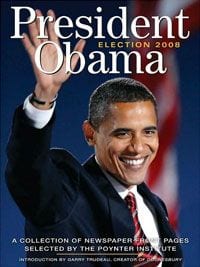
Although Barack Obama’s election victory was the result of millions of first-time voters hitting the polls across the US, the real victory came with his – and his supporters – use of technology to spread his campaign messages and policies. Subsequently, the election of 2008 will be remembered less for where you were when Obama was declared the winner and more for how you found out. Was it via text or instant message? Or through Facebook, Myspace or a blog? Or maybe you just through watching a live feed?
The irony is that on the morning of 5 November 2008, Americans and most global citizens scrambled for a commemorative token that most consider obsolete: a newspaper. What is it about a newspaper headline or front page that is so endearing? Why is it that despite the avalanche of technology and multimedia that tends to drown us on a daily basis, we still seek comfort in certain images, usually those first captured on the front pages of newspapers?
Perhaps because at the end of the day, all the technologies that we use to capture our news cannot provide us with that old-fashioned keepsake that can be preserved for years. As Doonesbury creator G.B. Trudeau writes in the introduction to President Obama Election 2008, nothing compares to the “crisp, tactile, iconic artifact that is a daily newspaper – that tangible proof that something bad had really happened.”
With that in mind, Florida’s Poynter Institute has compiled the best newspaper front pages from across the US and the world that commemorated Obama’s election victory. Their slim volume contains front pages from 41 of the 50 states, two national papers (USA Today and The Wall Street Journal) and 12 international papers. However, rather than just highlight these papers, the editors have included some awesome trivia and information that when read, really explain why some of these papers were chosen among the thousands that the Poynter Institute had to sift through.
Therefore, although it is interesting to see that Yale University’s newspaper was included as one of the handful of college papers, their inclusion really becomes profound when we read, “this is the first election since 1968 that has not had a Yale alumnus on the Republican or Democratic presidential ticket.”
Alternatively, the front page of The Washington Post, the largest circulated paper in the District of Columbia, which still has no Congressional representation, but for whom, according to this book, “three-quarters of registered voters are Democrats.” That The Washington Post provided a photo of Obama supporters watching the election results at Busboys and Poets, the D.C.-based, Langston Hughes-inspired café and bookstore, only adds to the tremendous satisfaction that Obama’s victory must have given to the large and diverse African-American community in the capital.
What stands out in this collection are the common themes in the paper layouts, as well as the truly unique attempts to capture history. For example, several papers went with a full-page color shot of just Obama. These included the Chicago Sun-Times, Portland Oregonian and Harrisburg Patriot-News. I also counted a whopping 22 newspapers that featured a color shot of the new First Family – a photo that originally seemed unique, but grew to be banal when you realized how often it was used.
What was also striking was how completely different newspapers, representing very different demographics and communities, could come up with the same ideas for their post-election issues. How was it that The Times-Picayune in exceedingly diverse New Orleans and The Staten Island Advance, representing the only NYC borough to vote for McCain, both came up with front pages showing the faces of all 44 presidents, except the first 43 are in black and white and only Obama’s face is in color?
The best selections in terms of sheer chutzpah and ingenuity would have to be Leo, an alternative paper in Louisville, Kentucky, that put Obama’s head on a 2009 penny; Warsaw, Poland’s Gazeta Wyborcza that invented a new word and used it in giant type, “Obameryka”; and Columbia, South Carolina’s The State. This last paper contrasted the simple headline of “History” and Obama’s grinning face with a smaller article beneath it, titled, “South Carolina Choose McCain” with an eerie shot of the Arizona senator with his hands outstretched like Emperor Palpatine in Return of the Jedi [“If you will not be turned [Barry], you will be destroyed!”].
In the end, the editors at the Poynter Institute have really taken the time to find some unique and colorful newspapers to spice up this collection. This book is moderately priced and should make a great gift for anyone interested in newspapers, journalism and the power of the written word.

![Call for Papers: All Things Reconsidered [MUSIC] May-August 2024](https://www.popmatters.com/wp-content/uploads/2024/04/all-things-reconsidered-call-music-may-2024-720x380.jpg)



